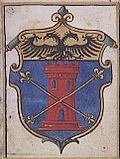History
An ancient family of the Milanese aristocracy from Milano Porta Nuova, according to the tradition of the descendant line of the De La Tour di Borgogna, of whom two members moved around the year 1000 in Val Sassina to marry two daughters of Count Tacius. The De La Tour, in turn, are said to be descendants of Anscario I, count of Oscheret (kingdom of Burgundy) and later marquis d'Ivrea, related to the imperial family of Charlemagne.
The Della Torre family had been enfeoffed by the archdiocese of Milan with vast territories reaching as far as the Canton Ticino, whose main body was the county of Valsassina, with the fortified village of Primaluna in the center.
The first notable member was one Martino, nicknamed Il Gigante ("The Giant"), who fought in the Holy Land during the Crusades. His son, Jacopo, married Berta Visconti and was captain of Milan. His nephew Raimondo was bishop of Como in 1262–1273 and Patriarch of Aquileia (1273–1299), while another nephew, Salvino, was podestà of Vercelli.
Jacopo's son, Pagano, became capitano del popolo of Milan in 1240, holding the position until his death in 1247. His brother Martino (III) imposed his personal power over the city, beginning the Torriani lordship, which lasted some 50 years. He died in 1259 and was succeeded by another brother, Filippo. Torriani possessions included Bergamo, Lodi, Novara and Vercelli. The Torriani were staunch members of the Guelph faction in Italy.
Napoleone, son of Pagano, gained power in Milan in 1265, but was defeated by the Visconti in 1277; he died the following year, imprisoned. His brother Francesco was podestà of Brescia, Alessandria, Bergamo, Lodi, and Novara, and was killed in the Battle of Desio (1277), against the Visconti. With that victory, the Visconti acquired power in Milan. In 1302, they were ousted in turn. Corrado Mosca, who had already been signore between 1277 and 1281, was returned to power, which he held until 1307 when he was succeeded by his son Guido. Having tried to incite the people against Emperor Henry VII, Guido was forced to flee and died in 1312.
Florimondo della Torre, son of Corrado Mosca, attempted in vain to regain power in Milan. His son Pagano was bishop of Padua and Patriarch of Aquileia from 1319 to 1332. Another member of the family, Cassono (or Gastone), had been Archbishop of Milan from 1308 to 1316 and patriarch of Aquileia from 1317 to 1318. Paganino, Corrado's youngest son, was podestà of Como and Senator of Rome. Lodovico della Torre was also Patriarch of Aquileia (1359–65).
Salvino della Torre's descendant Eriprando married Eurilla, daughter and heiress of the Count of Valsassina. [1] Made Barons zum Creutz by the Holy Roman Emperor in 1532, the Carinthian branch, called von Thurn und Valsassina, became Imperial counts in 1541, [1] acquiring Bleiburg castle in 1601, still the family seat. In 1552, they obtained the post of hereditary marshal in the County of Gorizia, where their ancestral nobility had been recognized in the person of Valveno della Torre in 1329. [1] A later member of the Torriani, Girolamo, was named Count of Valsassina by Emperor Charles V, and held possessions in Moravia until his death in Venice in 1530. Francesco Torriani was counsellor of Emperor Ferdinand I and baron of the Holy Roman Empire: he was ambassador to Venice (1558). Carlo Torriani was governor of Trieste in 1666.
Other families took on the name della Torre (or German von Thurn) without being male descendants of the Milan family (like the countess Alexandrine von Taxis in 1650, changing her family name to Thurn und Taxis, or cardinal Carlo Rezzonico, who in 1758 became Pope Clement XIII). Although both of these two families had similar names and both later belonged to the German and Austrian nobility, they were not to be confused, as they are related only through the female line, and as such, were not agnatically part of the same noble House. Their cognatic cousins, the House of Thurn und Taxis were raised to the dignity of Reichsfürst in 1695 by Leopold I, Holy Roman Emperor, only to be mediatised in 1806 after the dissolution of the Holy Roman Empire.





